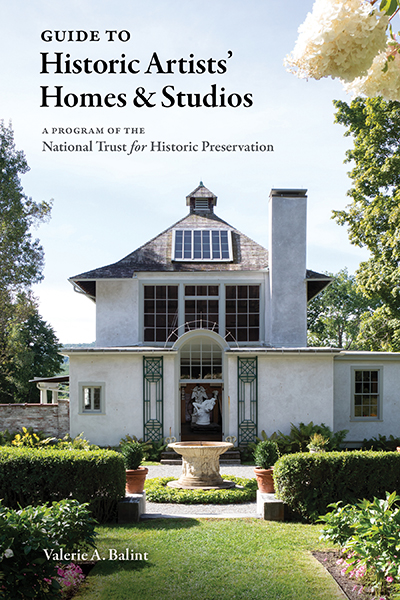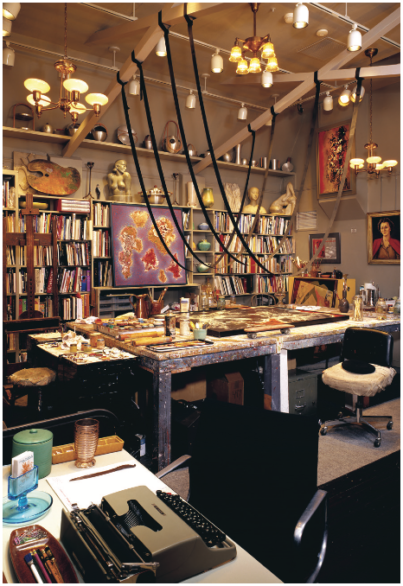

Guide to Historic Artists’ Homes & Studios
A Program of the National Trust for Historic Preservation
Valerie A. Balint | Foreword by Wanda M. Corn
Preface by Donna Hassler and Katherine Malone-France
———————————–
ISBN: 978-1-61689-773-4
6 X 9 IN / 256 PP / 225 COLOR & B+W PHOTOGRAPHS $29.95 / PAPERBACK WITH FLAPS
PUBLICATION DATE: JUNE 2, 2020
————————-
“This highly anticipated guide presents an intriguing cross-section of creative spaces from New England to California, enticing us to travel—both virtually and physically—to the homes and studios that were carefully crafted reflections of the painters, sculptors, and designers who occupied them. With accessible text and handsome illustrations, Guide to Historic Artists’ Homes & Studios is a resource for all—from long-time preservationists to those experiencing the power and pleasure of artistic place for the first time.”
— Thayer Tolles, Marica F. Vilcek Curator of American Paintings and Sculpture, The Metropolitan Museum of Art, and President, Saint-Gaudens Memorial
———
Cover photo by Don Freeman, 2019
~~~~~~~~~~~~~~~~~~~~~~~~~
Art doesn’t happen by chance. Artists generate ideas, but they need space and time to develop these ideas. For visual artists, it all comes together in the studio, the place where that spark of inspiration catches fire. For most artists, the studio is more than one room set aside for work. It encompassed the whole environment where creativity is nurtured.This environment includes homes, gardens, and all the places where family and friends gather and interact. These homes and studios of artists were catalysts for creativity.
Twenty years ago, the National Trust for Historic Preservation, with lead support from the Henry Luce Foundation and the Jessie Ball duPont Fund, created the Historic Artists’ Homes and Studios (HAHS) network. Today, HAHS comprises 44 preserved artists’ homes and studios throughout the country—all of them open to the public.
From the desert vistas of Georgia O’Keefe’s New Mexico ranch to Winslow Homer’s studio on the rocky, windswept coast of southern Maine, the homes and studios in the network are sites of extraordinary creativity. Guide to Historic Artists’ Homes & Studios (June 2020, $29.95 ) is the first guidebook to the network, conveying each artist’s visual legacy and setting each site in the context of its architecture and landscape, which often were designed by the artists themselves.
—–

Atrium with Amor Caritas. Courtesy U.S. Department of the Interior, National Park Service, Saint-Gaudens National Historical Park, Cornish, N.H.
————-

Vance Kirkland’s studio workroom, where he sometimes suspended himself above his paintings in straps to accomplish large paintings. Photograph by Ron Ruscio, courtesy Kirkland Museum of Fine & Decorative Art, Denver, Colo.
—–
Through portraits, artwork, and site photos, discover the powerful influence of place on American greats such as Andrew Wyeth, Grant Wood, Lee Krasner, and Donald Judd, as well as lesser-known but equally creative figures who made important contributions to cultural history—multimedia artist James Castle, photographer Alice Austen, and muralist Clementine Hunter among them.
—————
“Spread across the country, some of these sites tell stories of a single artist, some of artist-couples, some of artist colonies, and some of generations of artists who worked in the same space,” writes Wanda M. Corn, Chair, Historic Artists’ Homes and Studios Advisory Committee, in her foreword. “The HAHS motto is ‘Witness Creativity,’ and creativity knows no bounds. Each and every one of these sites makes me thankful that these places are now being acknowledged, cared for, and interpreted as part of this country’s art history and heritage.”
—————
Organized by region, Guide to Historic Artists’ Homes & Studios weaves the history of the sites’ architecture and landscape with the artists’ biographies and their visual legacy. The guide features portraits of the artists, examples of their artwork, site descriptions, and photographs as well as visitor information and a site map.
Author Valerie Balint writes in her introduction, “Art is the result of both a physical and mental practice, but what is displayed in a museum represents only the results. Artists’ homes and studios help us imagine the form of this rigorous process by allowing us to see where art was actually made and exposing us to the same input as the artists: they reveal not only an artist’s process, but what in the environment inspired it.”
Valerie A. Balint is the program manager of Historic Artists’ Homes and Studios, which is based in the Berkshires of western Massachusetts. She is the former interim director of collections and research at Frederic Church’s Olana and a longtime advocate of preserved artists’ spaces and public art.
Created with invaluable support from the Henry Luce Foundation and the Wyeth Foundation for American Art, Guide to Historic Artists’ Homes & Studios is an invitation to discover the abundant riches these sites have to offer.
—–
National Trust for Historic Preservation and HAHS
The National Trust for Historic Preservation protects significant places representing our diverse cultural experience by taking direct action and inspiring broad public support. Its purpose is to save the places that shape our American experience, honoring our individual and shared stories, and inspiring a more vibrant future. Established in 1999, Historic Artists’ Homes and Studios (HAHS), a program of the National Trust for Historic Preservation, is a coalition of museums throughout the country that were the homes and studios of American artists.The program aims to preserve the nation’s legacy of creativity in the visual arts and to inspire meaningful personal experiences at authentic creative places.
HAHS is administered at Chesterwood, a site of the National Trust and the former summer home, studio, and gardens of sculptor Daniel Chester French in Stockbridge, Mass. For more information about the HAHS program, visit artistshomes.org.
————————
Supported by:

~~~~~~~~~~~~~~~~~~~~~~~~~~~~
National Trust for Historic Preservation and HAHS
The National Trust for Historic Preservation protects significant places representing our diverse cultural experience by taking direct action and inspiring broad public support. Its purpose is to save the places that shape our American experience, honoring our individual and shared stories, and inspiring a more vibrant future. Established in 1999, Historic Artists’ Homes and Studios (HAHS), a program of the National Trust for Historic Preservation, is a coalition of museums throughout the country that were the homes and studios of American artists.The program aims to preserve the nation’s legacy of creativity in the visual arts and to inspire meaningful personal experiences at authentic creative places.
HAHS is administered at Chesterwood, a site of the National Trust and the former summer home, studio, and gardens of sculptor Daniel Chester French in Stockbridge, Mass. For more information about the HAHS program, visit artistshomes.org.
—————-
ISBN: 978-1-61689-773-4
6 X 9 IN / 256 PP / 225 COLOR & B+W PHOTOGRAPHS $29.95
/ PAPERBACK WITH FLAPS
PUBLICATION DATE: JUNE 2, 2020
———————-
- Amazon: https://www.amazon.com/Guide-Historic-Artists-Homes-Studios/dp/1616897732/
- org: https://bookshop.org/a/2057/9781616897734
- Indiebound: https://www.indiebound.org/book/9781616897734
- PAPress: https://www.papress.com/goItem.dna?isbn=9781616897734
———-
Princeton Architectural Press | 202 Warren Street | Hudson, NewYork 12534 | www.papress.com
==============================

AAQ Resource: Riverhead Buick | GMC
___________________________________________________
